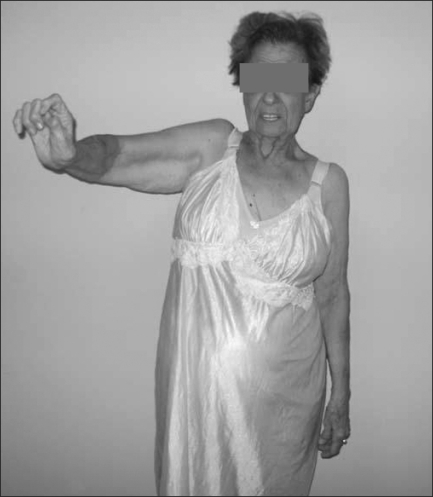Korean J Pain.
2010 Dec;23(4):258-261. 10.3344/kjp.2010.23.4.258.
Physical Therapy and Rehabilitation of Complex Regional Pain Syndrome in Shoulder Prosthesis
- Affiliations
-
- 1Orthopedics and Traumatology, Istanbul University, Istanbul Medical Faculty, Istanbul, Turkey. deryacavga@hotmail.com
- KMID: 1454710
- DOI: http://doi.org/10.3344/kjp.2010.23.4.258
Abstract
- We report a 66-year-old woman with complex regional pain syndrome (CRPS) 1 treated with combined medical and active physical therapy. She was diagnosed with CRPS 1 following partial shoulder prosthesis due to proximal humerus fracture. Despite continuous medication and physical therapy, there was no improvement in her pain and functional outcome. Her overall pain was decresed by stellate ganglion block 3 times in two weeks conducted during the second month of the follow-up period. Following the ganglion blockades, pain and the other symptoms were decreased intermittently but range of motion (ROM) and functional status were not satisfied as much as expected. After the third month of follow-up, her passive and active ROM of the shoulder joint was increased after application of manipulation under general anesthesia. In conclusion, because CRPS 1 remains one of the most difficult pain syndromes, early diagnosis and treatment are important to have adequate functional results from physical therapy. Manipulation under general anesthesia may be an additional effective treatment tool to obtain functional improvement in some patients diagnosed with CRPS 1.
MeSH Terms
Figure
Reference
-
1. Baron R. Mcmahon SB, Koltzenburg M, editors. Complex regional pain syndrome. Text book of pain. 2006. 5th ed. Elsevier, Churchill Livingstone;p. 1011–1027.2. Doury P, Dequeker J. Klippel JH, Dieppe PA, editors. Algodystrophy/Reflex sympathetic dystrophy syndrome. Rheumatology. 1998. London: Mosby;p. 1–8.3. de Mos M, Huygen FJ, van der Hoeven-Borgman M, Dieleman JP, Ch Stricker BH, Sturkenboom MC. Outcome of the complex regional pain syndrome. Clin J Pain. 2009; 25:590–597. PMID: 19692800.
Article4. Schwartzman RJ, Erwin KL, Alexander GM. The natural history of complex regional pain syndrome. Clin J Pain. 2009; 25:273–280. PMID: 19590474.
Article5. Sigtermans MJ, van Hilten JJ, Bauer MC, Arbous MS, Marinus J, Sarton EY, et al. Ketamine produces effective and long-term pain relief in patients with Complex Regional Pain Syndrome Type 1. Pain. 2009; 145:304–311. PMID: 19604642.
Article6. Everett A, Mclean B, Plunkett A, Buckenmaier C. A unique presentation of complex regional pain syndrome type I treated with a continuous sciatic peripheral nerve block and parenteral ketamine infusion: a case report. Pain Med. 2009; 10:1136–1139. PMID: 19744217.
Article7. Finch PM, Knudsen L, Drummond PD. Reduction of allodynia in patients with complex regional pain syndrome: a double-blind placebo-controlled trial of topical ketamine. Pain. 2009; 146:18–25. PMID: 19703730.
Article8. Daly AE, Bialocerkowski AE. Does evidence support physiotherapy management of adult Complex Regional Pain Syndrome Type One? A systematic review. Eur J Pain. 2009; 13:339–353. PMID: 18619873.
Article9. Gellman H. Reflex sympathetic dystrophy: alternative modalities for pain management. Instr Course Lect. 2000; 49:549–557. PMID: 10829209.
- Full Text Links
- Actions
-
Cited
- CITED
-
- Close
- Share
- Similar articles
-
- Musculoskeletal Problems in Upper Extremity after Stroke
- The Comparision of Effects between Stellate Ganglion Block and Oral Corticosteroid Therapy in Post-stroke Complex Regional Pain Syndrome
- Contralateral Mirror Image Spreading in Post-Stroke Complex Regional Pain Syndrome
- Complex Regional Pain Syndrome Type I after Stroke
- Infrared Thermal Imaging in Hemiplegic Patients of Upper Extremity by Stroke


